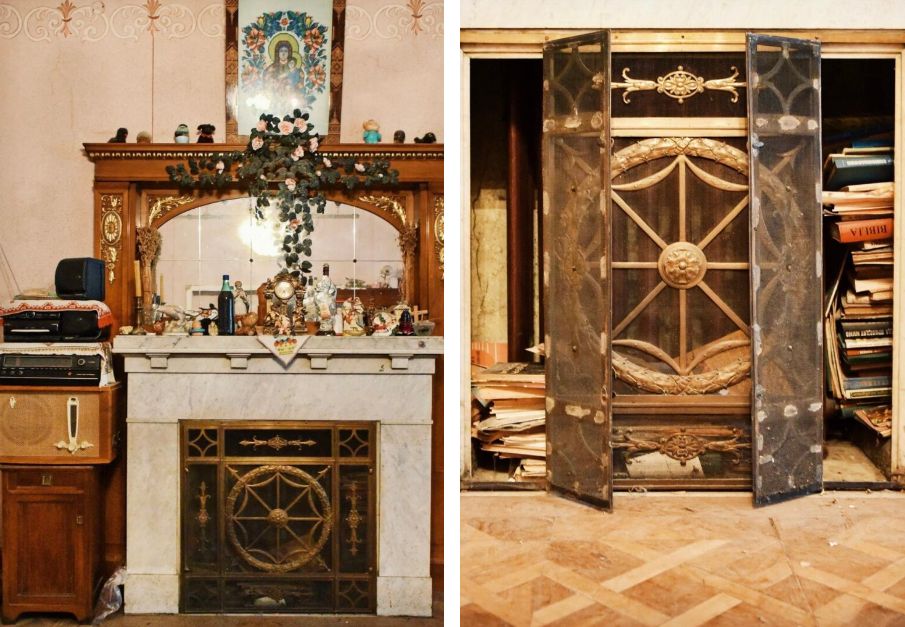The secrets of the apartment at @kopernika_12: stained glass, stucco and even a fountain
How to encourage owners of apartments in historic buildings to approach the arrangement of their accommodation carefully? After all, the presence of authentic elements only increases the value of the property, and this is important for every potential user of real estate in a historical environment to understand.
The Heritage Bureau talked to the owner of an apartment in a historic building to find out what attracts potential buyers of an apartment with authenticity, what has been preserved here, and how to consciously carry out restoration work in such an apartment.
The residential building at 12 Kopernyka St. was built in 1908 according to the project of architects Edmund Zhykhovych and Michal Luzhetskyi. It is an architectural monument of local importance.
Why accommodation in a historic building?
I chose to stay in a historic building because of its unique style and atmosphere that cannot be found in newer buildings. I love the sense of history and connection to past generations that you get from living in a place like this. In fact, the announcement of the sale of this apartment caught my eye quite by accident. But in general, I really like apartments with authentic elements. This adds a special charm and character to the room. As for this apartment, it impressed me with a large number of preserved details, which is probably why I decided to buy it.
What is hidden behind the door of the apartment on Copernicus?
Initially, it was a large residence with a total area of 200 m2, but during the Soviet period it was divided into communal apartments. The previous owners did not carry out major renovations, so authentic elements have been preserved in the interior. Although it sounds rather absurd, quite often the lack of funds becomes the savior of authentic luxury. This apartment was incredibly lucky, because time passed, owners changed, and yet, it waited for that person who understands its cultural value. Here, I want to preserve every corner and adapt it to modern needs
Currently, the entrance to this property is not through the main staircase, but through a rough spiral staircase. In the volume of the stairwell, a mine for supplying coal to the floors has been preserved. Previously, these stairs were used as a personal entrance to the kitchen for the maid. In addition, she had her own small bathroom, a window that once looked out onto the spiral staircase, and a sitting room. This made the project a little more difficult for us, because we also immediately enter the kitchen from the entrance. Authentic tiles from the Czech company RAKO (a 130-year-old brand), which we carefully cleaned with our own efforts, are preserved here, as well as an authentic ceramic washbasin on ceramic legs. And although it is in a bad condition and with a missing drain fitting, we plan to restore it and adapt it to a modern kitchen.
Next, we enter a large corridor that leads to a small room from which there used to be a passage to the rest of the apartment. And on the side there is a huge hall, from which a small balcony opens into a cozy courtyard. This is a real treasure of this property. Stucco molding, artistic parquet and antique furniture have been preserved here, and a conventional portal on columns divides the space into 2 parts – the main, living and balcony space with an authentic wall fountain decorated with marble and stars. Just imagine how wealthy the first owner, lawyer Leon Tsion, was, if he could afford a fountain in the apartment. By the way, we have an assumption that the lawyer had a certain relationship with the Masonic lodge, because their symbols can be seen in the interior of the residence. For example, in stucco, or on a fountain.
From the hall, we can get to a small balcony with preserved forged elements, or to a room whose windows look out onto the yard-well of the house.
Undoubtedly, the highlight of this accommodation is the preserved stained glass windows of the famous factory of Stanislav-Gabriel Zhelenskyi. It is hard to believe that they managed to survive until this time.
Another interesting find in the house is a marble pseudo-fireplace framed by a wooden portal, which serves as a decoration for the only surviving cast-iron radiator.
Authentic joinery, three large built-in wardrobes and some antique furniture have been preserved here.
A special find is an old Diederichs Frères piano dating back to the 19th century. XIX- beginning 20th century. It was the oldest piano factory, founded in 1810 by Fyodor Fyodorovych Diederichs, a native of the Duchy of Braunschweig.
A century ago, this hall was a place of recreation and entertainment. They say that once there was a huge pool table, the leg of which was found in the attic by a neighbor, as well as a table for playing cards with a marble top, which, unfortunately, did not survive.
My main motivation in restoring the authenticity of the apartment is the desire to preserve the values and culture of past generations, as well as to contribute to the history of this place.
What difficulties did you encounter during the work on this object?
Currently, the restoration work is only a few months old and the most difficult is yet to come. Among the main challenges in this apartment are restoration of stucco decoration, restoration of an authentic kitchen sink, work with old tiles in the kitchen (repositioning and restoration of losses

